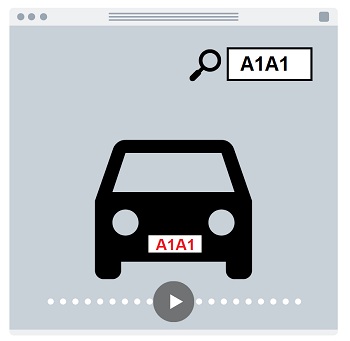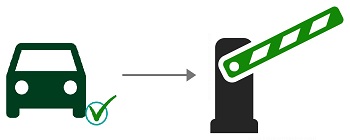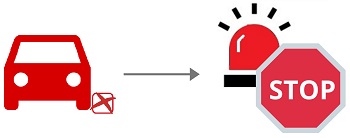Advanced license plate recognition with Additional module
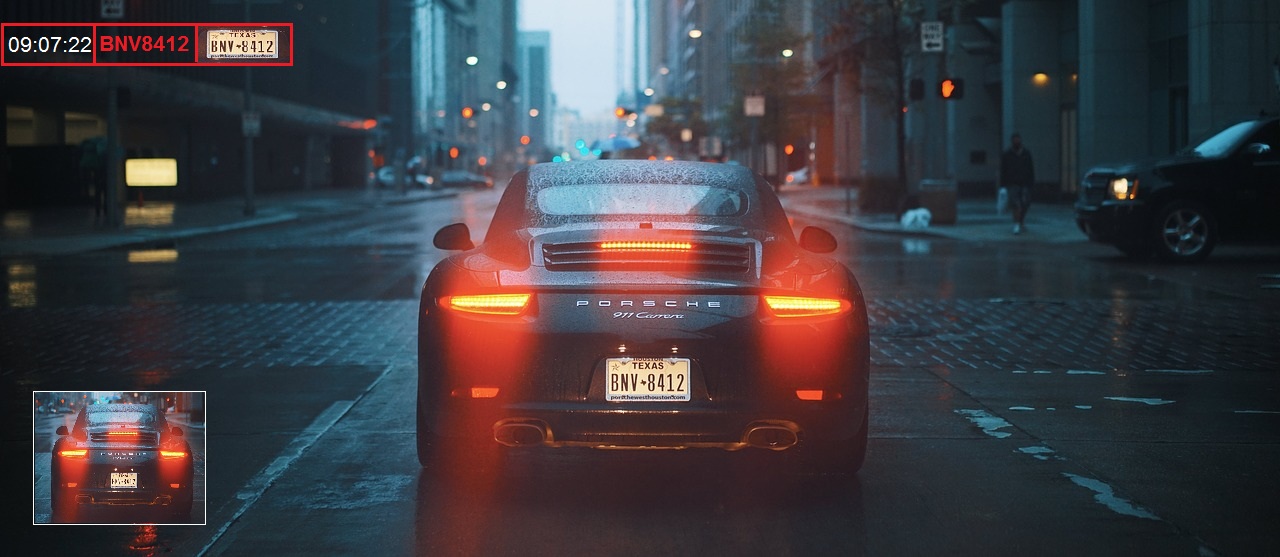

Xeoma’s ‘ANPR’ Additional module is our own tool for live detection of a vehicle and its license plate, reading its license plate number, saving the information and trigerring various reactions.
It works with unlimited amount of vehicles in camera sight, with any vehicle speed, and any camera.
Works on Windows, Linux, Mac, Android and Linux ARM (32 and 64 bit).
Xeoma’s automated number plate recognition (ANPR, for short) is a professional feature that allows to analyze a camera video stream to detect an approaching vehicle (both light cars and load carrying vehicles), locate its license plate, and read the digits in the plate.
Xeoma offers a variety of LPR tools to do the license plate recognition of over 70 countries which includes Xeoma’s own recognition tools as well as third-party utilities like openALPR, Platerecognizer, iANPR, etc. Read more about it in the ANPR main page.
The list of integrated tools is constantly expanding to allow for a wider choice of countries, accuracy of recognition, and its cost.
Advanced license plate recognition with the Additional module ‘ANPR’ is one of such tools for license plate recognition in Xeoma, developed by our company.
Our own module supports 14 countries so far, and provides all sides of ANPR: not only does it detect vehicles and read their license number, but also saves the video with this number in the frame, and triggers various reactions upon detecting any license plates, or license plate numbers from block or pass lists (including external ones).
With this module, you can create lists of license plates to react to, and assign automated reactions like opening the barrier, turning on the light, etc.
The module can be a part of complex systems: in parking lots, safe city programs, traffic monitoring, automation in transportation, business and private access control, etc.
Affordable one-time-payment price that doesn’t depend on a number of recognized license plates, combined with it accuracy, is what makes the tool stand out among other license plate recognition tools. Since we are its developers, we can modify and further improve the tool.
It’s also more convenient to use because you will not have to get in touch with other tools manufacturers and depend on their conditions.
|
Armenia |
Belarus |
Canada |
China |
Georgia |
Japan |
Jordan |
|
Kazakhstan |
Kyrgyzstan |
Mexico |
Russia |
Uzbekistan |
USA |
Iraq |
![]() More countries are availbale in Xeoma’s other supported license plate recognition tools
More countries are availbale in Xeoma’s other supported license plate recognition tools
![]() Need your country to be added to the Additional module ‘ANPR’? You can use our paid development program to have our team add the needed changes for you! Learn more about paid development
Need your country to be added to the Additional module ‘ANPR’? You can use our paid development program to have our team add the needed changes for you! Learn more about paid development

Works with all vehicles in view:
Recognizes license plates of all vehicles in camera’s field of view

Day/night, all-weather:
The same module works in different conditions, including weather conditions, in day or night-time.

Works with all vehicles types:
Recognizes license plates of all vehicle types.

Any speed:
Works with any speed of a vehicle, and can be used in high-speed highways, etc.

Flexibility and versatility:
Various reactions, including custom ones, integration with third-party systems.

Affordable price:
Affordable one-time-payment that does not depend on the number of frames or vehicles in camera sight. Unlike other LPR options in Xeoma, Additional module works even with the Xeoma Standard edition! Monthly rent available.

No special equipment or a powerful standalone server is required. Recognition load is on average 40% more than that of a regular camera in the program. Use online calculator to check hardware requirements
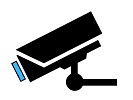
No special cameras with embedded recognition detectors required. Recognition processes are conducted on Xeoma’s side. High quality video stream is enough. Point the camera at an anggle that will allow computer vision clearly see objects, and make sure that the object is in the camera’s field of view for at least a few seconds.
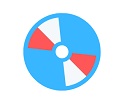
Works on a variety of operating systems from Windows, Linux, Mac OS X, Linux (ARM architecture) and Android families. Even on a micro computer like a Raspberry!
|
|
• detects vehicles in the camera field of view; • detects vehicles’ license plates; • recognizes digits in the vehicles’ license plates (with Xeoma recognition or third-party tools); |
|
|
• writes down recognized license plate numbers, date and time of recognition into a CSV report; • allows search through video records for specified license plate numbers; |
|
|
• allows adding of licenses to “white” or “black” lists to ignore or react to; • allows adding of text comments to each identified car; • allows use of an external database of license plates, for example, a city police database to search for missing cars; • generates events that can trigger external integrated systems (open the gate barrier, turn on the light, etc.); and many more! |
Why do we need license plate recognition system?
With the license plate recognition system you can easily automate the entry to the any enterprise territory. You no longer need to issue passes for customers and monitor if anyone has lost it. Your car license plate is your pass.
This system will allow you to control the number of vehicles on the territory. Driving in and out cars control will strengthen the security. Database will consist of “white” and “black” lists, it will help you to identify the intruder. Such system, implemented on the company territory, will provide control over the personnel and vehicles movement on its territory. Nobody will be able to enter the service area, as well as leave it without your permission. License plate recognition system can be implemented at gas stations, service stations, as well as to monitor transport conditions.
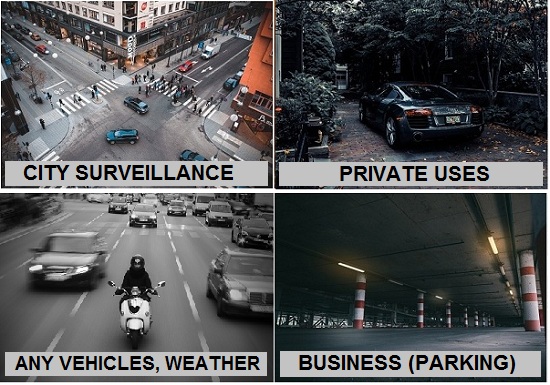
Additionally:
• can send an archive with the xml file of detected license plate and time of detection, and a photo of the vehicle (with the “ANPR Sending to FTP” module);
• can determine a moving vehicle’s average speed (and react to speed limit violation) (with the “ANPR Speed Receiver” and “ANPR Speed Sender” modules);
• can identify violators of traffic lights rules (with the “Color Recognition” module);
• can recognize violators of a speed limit when a hardware speed meter is used (with the “Vehicle Speed Detector” module). Read more about the Vehicle Speed Detector

XEOMA’S OWN RECOGNITION METHODS – ADDITIONAL MODULE ‘ANPR’ is our own development that uses improved license plate identification algorithms that we can develop by adding new types of plates and new countries.
The system includes algorithms of actions that allow us to recognize a license plate of an approaching vehicle by analyzing the video from the cameras.
Our own algorithms will provide good recognition quality in day and night hours in a wide range of weather conditions, as well as let you set the necessary system’s reactions for the recognition.
The recognition quality is over 98% (if you follow the recommendations).
You may also use the recognition by individual frames without using the video stream.
Simultaneous support for several checklists of license plates.
There is the opportunity to save and view the video stream from multiple cameras synchronously.
Operational schemes:
* Capture, identification and saving license plates in the database with or without verification.
* Comparing the captured license plates with the existing database in online mode in order to identify coincidences.
* Search for license plates in the archive according to the given license plate.
* License plate verification – the process of comparing the captured license plate on the video record to the given license plate.
Pricing policy:
Although the basic ‘ANPR’ module in Xeoma is powered by the Xeoma Pro edition, the Additional module ‘ANPR’ is an exception and is available also in Xeoma Standard edition, which is a double economy considering the Additional module’s affordable price.
This option is purchased separately as an Additional module and is activated over Xeoma Standard or Xeoma Pro licenses for as many cameras as will be using this module, independent of how many countries will be recognized! View prices and purchase licenses at affordable prices here
Try free:
You can try the Xeoma’s Additional module ‘ANPR’ before you buy it. To get a free trial, please fill in the request form below.
Countries recognized:
Former CIS – Armenia, Belarus, Georgia, Kyrgyzstan, Kazakhstan, Russia, Uzbekistan – USA and Canada, Mexico, China*, Jordan, Japan*, Iraq*.
Advantages:
* Supported OS: Windows, Linux, Mac, Android and Linux ARM.
* our own development and we can improve it according to your needs;
* good recognition success rate;
* all supported countries included into the license;
* can be used over a cheaper Xeoma Standard edition;
* no latency: works fully on your computer, does not send images to a cloud for recognition.
Disadvantages:
* requires an Additional license;
* limited (although expanding) set of supported countries;
* *(Only for China, Japan and Iraq): recognition of the Chinese, Japanese and Iraqi license plates requires a specific processor.
Intel 64-bit processors of the following series:
-IntelCore processors starting from the 4th generation (including 10+ generations);
-XEON processors starting from the 6th generation;
-Atom processors of the “C23”, “C25”, “C27”, “C33”, “C35”, “C37”, “C38”, “C39”, “P59”, “Z34”, “Z35”, “x5-E39”, or “x5-E8000” series;
-Processors Intel Xeon E5-24 series, i5-2450M or i7-2600.
• Municipal/police: automated scanning of city cameras for missing vehicles: stolen or known to belong to criminals.
• City surveillance: automated monitoring of road traffic situation, detection of violation of speed limit or traffic light conditions; autonomous work with fee charging systems.
• Business, corporate: automated entry to the enterprise territory. A vehicle’s license plate will be the pass.
• Business, corporate: automated alarms (or other reactions) at detection of vehicles from a black list (for example, belonging to fired employees or returning shoplifters).
• Personal residences: automated entry for whitelisted vehicles to a private residence; automated alarm at detection of vehicles from a black list (for example, from a restraining order after a separation trial).
• Farming: automated alarms (or other reactions) upon detection of any vehicles near ranging zones, even in far-off areas, with low Internet bandwidth.
and many more.


1. Download Xeoma for your device and launch it.
2. Request a trial license for Xeoma Pro or Xeoma Standard, and a trial license for the Additional module ‘ANPR’. Please note that this feature cannot be tested in the Trial mode of Xeoma, i.e. without a test license.
3. Activate the received trial licenses through Xeoma’s Main menu -> Registration -> Activate.
Advice: you can make sure that the licenses are activated successfully in Xeoma’s Main menu -> Information -> Active licenses.
4. Add your camera to Xeoma, or let Xeoma find and add your cameras in the local network. More about search for cameras in Xeoma
3. Add the ‘ANPR’ module to the chain:
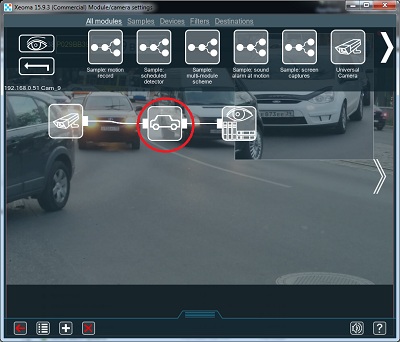
4. It is very important to select the correct tool for recognition in the ‘ANPR’ module settings. Tick only the country or countries that the Additional module supports:

If these options are greyed out and cannot be ticked in your Xeoma, go back to steps 2-3:
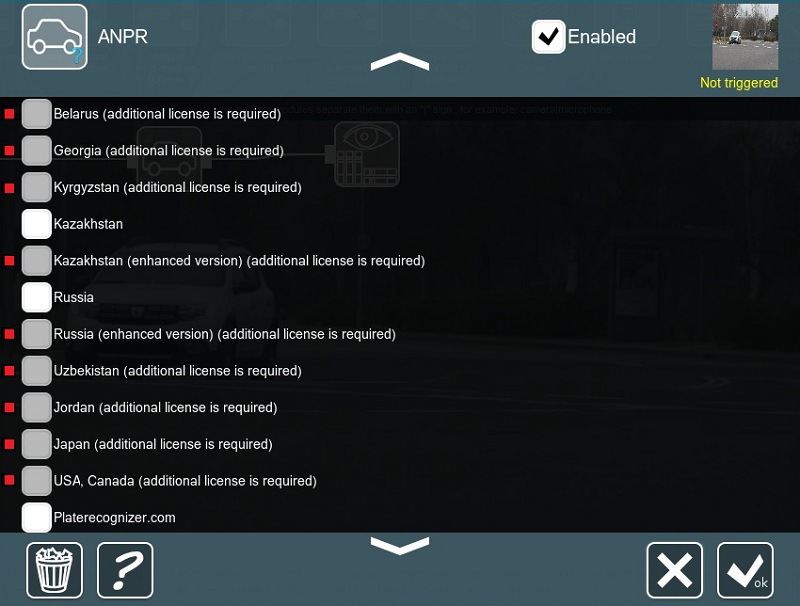

|
You will only see ‘China’, ‘Japan’ and ‘Iraq’ in the list of countries supported by the Additional module if your device complies with the requirements for its work. |

|
Important: to get better recognition results do not combine several recognition tools in one module. See also “Can I combine several recognition tools?” |
5. In the module settings specify the detection area. You can also specify the undetectable zones, for example, curbs or sidewalks. If you do not specify the search area, then Xeoma will analyze the full frame.
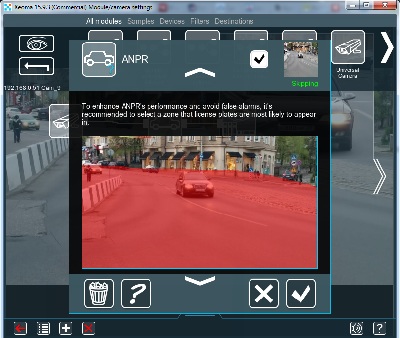
*In Xeoma version 20.10.13 and higher the green Skipping/yellow Not Skipping inscription is replaced with green Triggered/yellow Not triggered.
6. In the “License plate recognition” module you can specify the needed settings, for example,
Detection type:
– detects white list cars (the archive will be written only with license plates from the white list);
– detects cars not in white list(the archive will be written only with license plates not from the white list (the ones in the white list – will be ignored));
– detects any cars (the archive will be written with any license plates);
– detects absence of cars (the archive will be written only with segments in which there is no license plates);
– detects always (the archive will be written continuously);
– detects upon receiving signal from external third-party utility/URL (when you receive an http-request (field “Path/URL to the external module”) segment will be written to the archive.
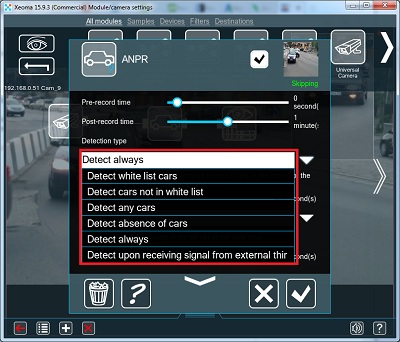
Displaying:
You can choose the angle at which to display information about and picture of the car license plate, as well as the display time (2 sec., 10 sec., 1 min. and etc.).
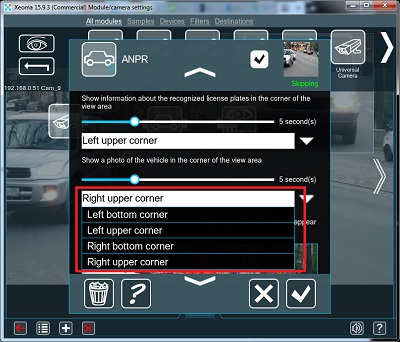
When detecting, the program records video frame with the detected vehicle and its license plate:
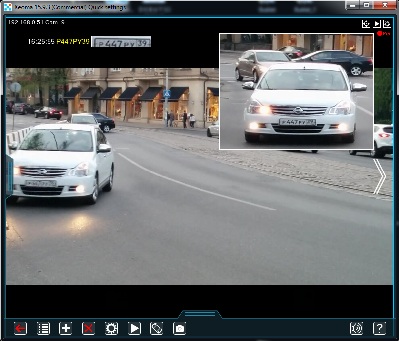
7. You can also write data to the cvs-reports (get them on the server in the Xeoma folder (Reports folder by default, but you can change the path to the folder in a field below).
This is how the cvs-reports will look like:
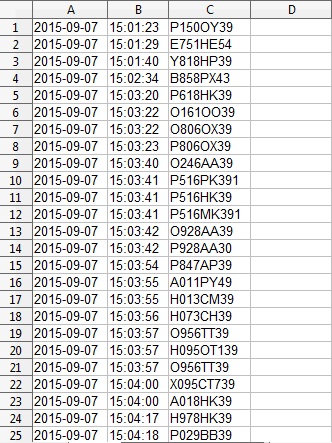
The CSV report is used to create a powerful reporting system. You can import such a CSV report into programs like Excel or LibreOffice and create reports of any complexity there. Either import it into mysql, and then use, for example, the mysqladmin web interface to generate any reports, or write a simple script in a few lines to automatically generate reports.
Try Xeoma for free! Enter your name and your email to send the license to in the fields below, and click the ‘Get Xeoma free demo licenses to email’ button.
We urge you to refrain from using emails that contain personal data, and from sending us personal data in any other way. If you still do, by submitting this form, you confirm your consent to processing of your personal data
License plate recognition in Xeoma allows you to use not only its own algorithms, but also third-party utilities for license plate recognition (for example, for recognizing license plates of countries that are not included in the main list. See more license plate recognition possibilities in Xeoma.
TYPE 1. Xeoma’s OWN RECOGNITION EMBEDDED INTO PRO
Countries recognized: Russia, Kazakhstan
Advantages:
* one of the cheapest options – already included into the PRO license
* easiest option – no additional licenses or tools needed
* fast start – works as soon as you add it, no need to download anything else
TYPE 2. USE OF openALPR TOOL FREE VERSION FOR RECOGNITION
Countries recognized:
Australia, Europe and UK, USA, Singapore, South Korea.
Advantages:
* no openALPR license required, you just need a Xeoma Pro license;
* automated work with Xeoma, done completely from Xeoma’s interface.
Disadvantages:
* limited amount of supported countries. If you want more or better recognition rate, you’ll need a paid version (see below).
* openALPR is a third-party tool. We do not own or develop it nor can we influence its development or quality.
TYPE 3. USE OF openALPR TOOL PAID VERSION FOR RECOGNITION
Countries recognized:
Argentina, Australia, Brazil, China, Europe and UK, Great Britain, GCC, India, Indonesia, Japan, Malaysia, Middle East, New Zealand, North America – USA, Canada, Mexico, Russia, Saudi Arabia, Singapore, South Africa, South Korea, Thailand, UAE, USA.
Advantages:
* a wide array of countries supported
* free (yet outdated) version available for Australia, Europe and UK, Singapore, South Korea, and USA.
* free test licenses available for tests of the paid version from the manufacturer’s site
Disadvantages:
* openALPR is a third-party tool. We do not own or develop it nor can we influence its development or quality
* licenses for the paid version can be quite expensive
* new version is paid and requires manual actions before you start using it
TYPE 4. USE OF “PLATERECOGNIZER” TOOL (PAID) FOR RECOGNITION
Countries recognized: 90+ Countries Across 6 Continents, including Americas, Europe, Africa, Asia, Australia. See website
Advantages:
* widest list of supported countries;
* high accuracy claimed by producer.
Disadvantages:
* setup harder than in other options;
* higher prices than in other options;
* this is a third-party tool so we cannot influence its development or accuracy.
If you would like to use another 3rd party tool for recognition, please let us know and we will see if it can be integrated into Xeoma.
- Point the camera in the direction of vehicles, facing license plates at right angle;
- A license plate should be entirely visible in the camera’s field of view;
- License plate’s tilt angle should be less than 10°;
- The image should be clear and not blurry;
- The size of characters for reliable recognition should be at least 14 pixels in height;
- Fasten the camera to minimize wind interferences, vibrations, etc.;
- Use proper lighting in the low-light circumstances (for example, an IR projector);
- Use long-focus objective;
- Set exposure to a minimum;
- Turn auto focus off.
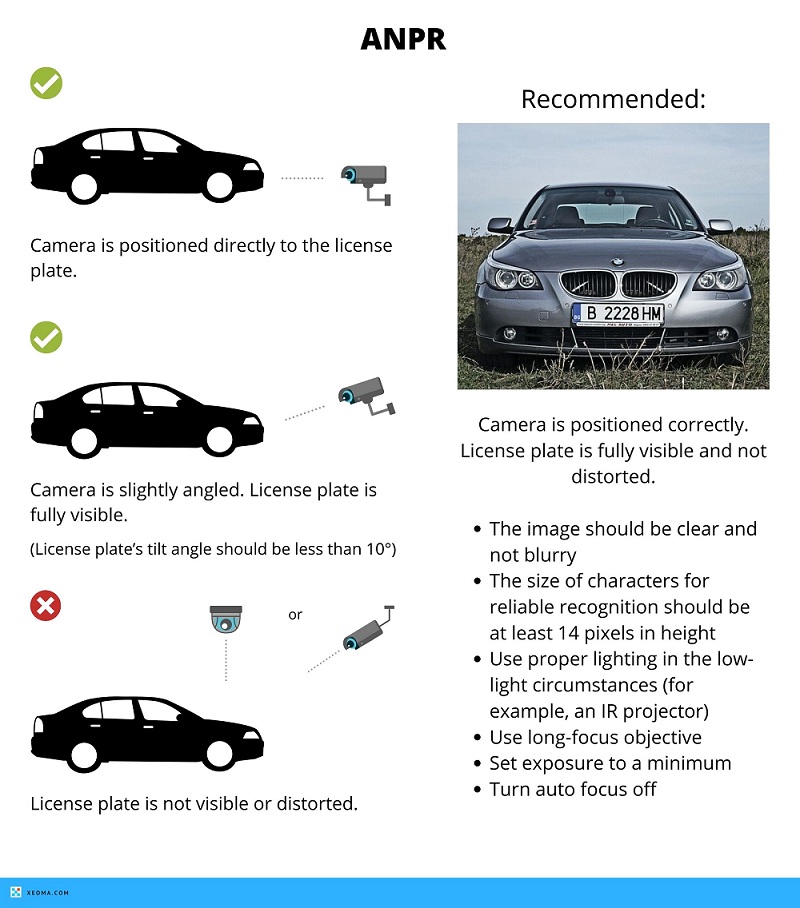
Anti-counterfeiting measures: license plate recognition only on cars (Xeoma Pro)
If a part of the LPR task is to recognize license plate numbers only in vehicles, and eliminate fraud when someone is holding the license plate, Xeoma has a way to do that.
Put the “Motion detector” module to the chain, and tick the ‘car recognition’ setting at the very bottom of the “Motion Detector” settings (only available in Xeoma Pro). This way the picture will not get to the modules in the chain (for example, to the License Plate Recognition module) if the motion detector does not detect the vehicle in the frame. If the accuracy of Xeoma’s motion detector is insufficient, you can use the more powerful “Object Recognition” Additional module based on artificial intelligence instead.
Integration with external systems:
Xeoma modules can be easily synchronized with external systems and devices. For example, you have your own database and you want the number plates detected by Xeoma to be checked if they are/aren’t from your database. After the plates are checked, destination modules will/will not start working (depending on your settings).
If you want to synchronize ANPR in Xeoma with an external system, you need to configure data transfer to HTTP Server. It can be done in 2 simple steps:
1. Open the ANPR module’s settings and choose “Detect upon receiving signal from external third-party utility/URL” as a detection type.
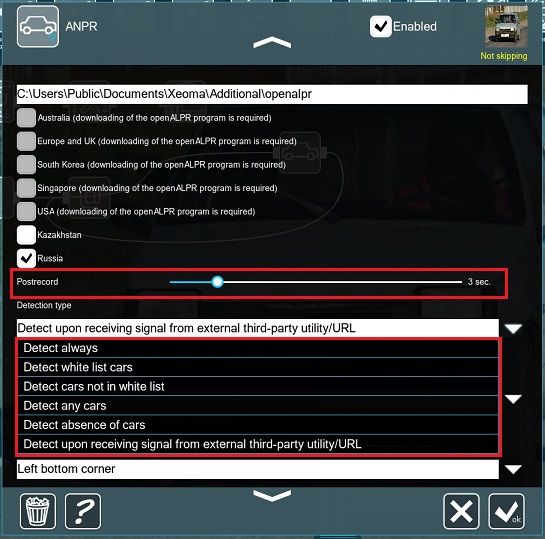
2. Then enter the external script’s URL (it can be e.g. CGI-script) into the “Path/URL to an external module” field in ANPR module’s settings.
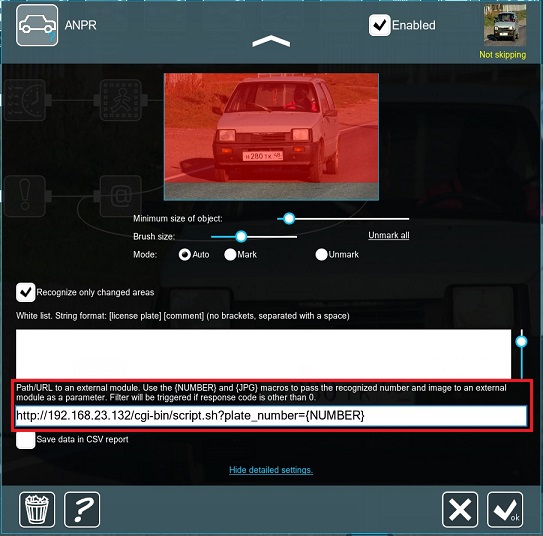
By using {NUMBER} macros information about the recognized license plate will be passed to the external module as a parameter. You can also specify static parameters (not macros) there.
After the data transfer is configured, each time the module is triggered information about the detected license plate number will be passed to HTTP Server via URL parameter.
E.g. if the license plate number detected by Xeoma is found in the external database, integration is set to start recording into Archive for the time specified in the settings of Postrecord (see Image 1).
I.e., the scheme is: Xeoma detects a license plate number → a command is being sent to HTTP Server → Server replies with e.g. 0 or 1 (0 – there’s no record to Archive, 1 – recording for 3 seconds (see Postrecord settings) is enabled).
If everything is done correctly, ANPR will be synchronized with external systems and devices.
Xeoma Pro also has a “ANPR Sending to FTP” module that forms an archive with violation images and a xml file with time and date, and thus can be used for fine-imposing systems.
Traffic rules violation: software speed detector
Starting with Xeoma Beta 19.11.26, the software has pair modules “ANPR Speed Sender” and “ANPR Speed Receiver”.
These two types of modules in combination will help estimate speed with which a vehicle has crossed two control points. In the receiver module you can set a specific time that this path should be crossed in, and if a vehicle passes it faster, it is breaking the speed limit. The modules can be integrated into various road fine ticket systems.
Read more about the module
Traffic rules violation: hardware speed detector
The “Vehicle speed detector” Additional module allows you to find and identify vehicles violating the speed limit in the monitored area. This module works in conjunction with the “License plate recognition” module, which detects a vehicle in the frame, looks for a license plate and recognizes its symbols, and the “ISKRA DA/40” hardware speed meter appliance, which refers data about speed limit violations to Xeoma. This combination can be used in conjunction with a system for automatic imposing fines in projects such as “Safe City”. Read more about the module
Traffic rules violation: ignoring the red light
There are several options in Xeoma that can be used to work with traffic light equipment:
“Color recognition” is a module in Xeoma based on Artificial Intelligence and deep machine learning. This module is designed to recognize color by means of computer vision.
Such recognition is especially highly-demanded for traffic offense detection in terms of “Safe city” project, in co-working with thermal imaging cameras (for example, for fever detection), or any other appliance where a particular color should be detected. Read more about the module
The “Modbus Controllers” Additional module of the Xeoma video surveillance software is designed to receive commands from controllers operating under the Modbus protocol to trigger the necessary reactions in Xeoma. This is a very popular type of controller used in automation, “smart home” systems, as well as in various equipment (traffic lights, etc.). You can set different reactions for different signals of such a controller, for example, to recognize a vehicle license plate and impose a fine if it is driving through a red light. Read more about the module
Traffic rules violation: lane crossing
A combination of “ANPR” and “Cross-Line Detector” modules (also included in the Xeoma Pro edition) can be used for detection of vehicles that cross the stop line or drive in the wrong lane. Read more about the module
Frequently Asked Questions
1. I need to recognize license plates of two countries: Armenia and Kazakhstan. Do I have to buy a license twice?
No! The license for the Additional module ‘ANPR’ opens up an opportunity to recognize license plates from any or all of 12 countries, including both these countries – Armenia and Kazakhstan.
2. At what height should the camera hang in order to recognize license plates? Is a 2 megapixel camera sufficient for recognition?
When selecting the height of the camera placement, we recommend to pay attention to whether the license plate is clearly visible in the camera or not. It should be clear and no objects (trees, poles, etc.) should cover it. The optimal height of the camera is 1-2 meters.
2 megapixels – this is Full HD video (1080p), in this resolution you can distinguish a lot of details, so it is quite enough for the effective work of the module.
We also recommend providing sufficient lighting of the space where license plates will be recognized in the evening and at night.
3. License plate recognition does not work or is not accurate enough. What can I do to improve that?
Here are some advice that might help:
1) Make sure that the camera chain follows the general workflow logic: video stream is going from the ‘Universal Camera’ module to the ‘ANPR’ module and is finished in a destination module or modules, e.g. ‘Preview’ or ‘Preview and Archive’.
Make sure that all modules are in the working state, and video stream is not filtered out by some modules in the chain. See more on how chains work in the Xeoma User Manual
Make sure that an adequate monitoring zone that ‘sees’ licenses plates is painted in the ‘ANPR’ module settings.
2) You are advised to always test Xeoma’s ANPR in real conditions or at least with a video from real conditions. Here’s how to use a video clip as a camera
If you have no other choice than to test with only a license plate (without a vehicle) or a picture of one, we recommend to untick the ‘React only to changing areas’ option in the ‘ANPR’ module settings, it can help a bit.
3) Make sure that the camera is positioned correctly: for best results the license plate should be facing straight at the camera which should have sharp still shots with decent quality for computer vision to be able to identify digits.
For most recognition methods, a license plate should be visible for a couple of seconds before it disappears so the distance between the camera and the vehicle when it first appears in the frame should be calculated accordingly.
If needed, add proper lighting for the camera to see clearer at night, or select night vision modules.
See more advice here
4) Try another recognition type. For example, there are several free and paid methods to recognize license plates of vehicles from UK and EU – free older version of openALPR, paid contemporary version of openALPR, and Platerecognizer. Visit this page to learn more about recognition methods and supported countries.
These recognition methods utilize different algorithms so if one method is not so good with your country’s licenses plates, you can try another, and there are chances that it will work better.
Attention: we do not recommend to use several methods at the same time. See more on that in question 4. Can I combine several recognition tools/methods at the same time?
4. Can I combine several recognition tools/methods at the same time?
You can use several recognition tools only in separate ‘ANPR’ modules. We do not recommend to use several recognition methods/tools within one ‘ANPR’ module as they will interfere with each other. Example: You’d like to have EU license plates recognized with the free openALPR tool and add recognition of occasional CIS region licenses plates with Platerecognizer – in this case you’d need separate ‘ANPR’ modules for each of the tools. Otherwise both of the tools will be trying to recognize all license plates, interfering with results and thus reducing the accuracy rate.
5. The Additional module ‘ANPR’ has only a part of countries that I need recognition for. What should I do?
You can either select another recognition tool in Xeoma that has all the countries you need, or purchase paid development from our team to add your country to the list of countries supported by the Additional module ‘ANPR’. We do not recommend using several recognition tools at the same time (even if for different countries) as they will interfere with each other.
6. I only need recognition for a part of countries that Additional module ‘ANPR’ supports. Can I have a discount for the ‘unused’ countries?
No. Xeoma’s Additional module ‘ANPR’ is sold as a bundle with recognition of license plates from all countries included into the bundle. Number of countries used does not affect the price.
Any questions? Assistance required? Reach out to us! We’ll be happy to help!
February, 4 2022
Read also:
Other Xeoma Pro features
All of Xeoma’s Additional modules
Car safety with video surveillance program Xeoma
Video surveillance system in the parking space
Video surveillance system at a petrol filling station
License plate recognition: Speed limit violation
How to work with the OpenALPR tool
Xeoma’s Support Pages: our contacts, F.A.Q., articles and guides about Xeoma features and more















